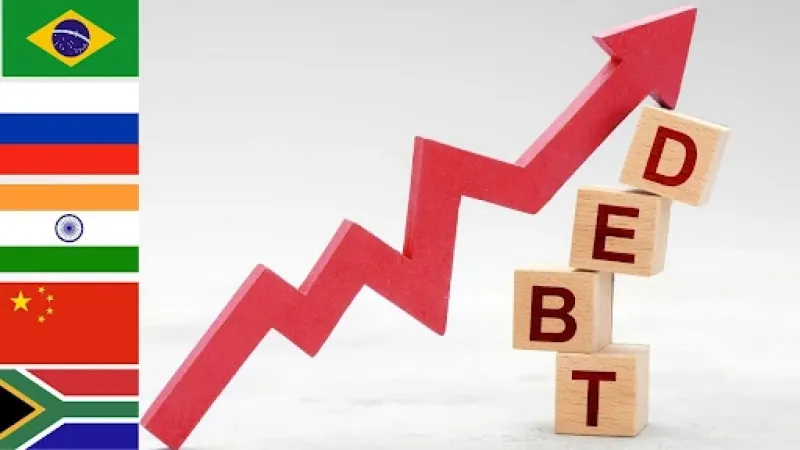
In an era marked by global economic uncertainties, rising national debts, and the constant pursuit of sustainable growth, understanding the connections between government borrowing and economic prosperity has never been more critical. From the ongoing debates about national budgets in developed nations to the ambitious development goals of emerging powerhouses, the question of "how much debt is too much?" looms large. A new study from the Indian Institute of Science Education and Research (IISER) Bhopal sheds light on this very question, specifically for the BRICS countries: Brazil, Russia, India, China, and South Africa, a bloc representing a significant portion of the world's population and economic output. This research offers fresh perspectives that could reshape how these nations, and others like them, manage their finances and engage with the global economy.
The study looks at two fundamental economic theories: the debt overhang theory and the exogenous growth theory. The debt overhang theory posits a non-linear relationship between public debt and economic growth. Initially, a government can borrow to fund essential infrastructure, education, or innovation, which can boost productivity and create jobs, leading to economic expansion. However, if debt continues to accumulate, the burden of servicing that debt or paying interest grows. This diverts funds away from productive investments, increases the perceived risk for new lenders, and can even lead to capital flight, ultimately stifling growth.
On the other hand, the "exogenous growth theory" emphasises that long-term economic growth isn't solely driven by internal factors like capital and labour accumulation, but also by external forces. Foreign Direct Investment (FDI) is a prime example; when foreign companies invest in a country, they bring not just capital but also new technologies, management expertise, and access to global markets, all of which can spur innovation and productivity.
Trade Openness (TO), which refers to a country's willingness to engage in international trade, also plays a vital role. It fosters competition, encourages efficiency, allows access to a wider variety of goods and services, and can lead to economies of scale. The study found that both FDI and TO significantly contribute to economic growth in the BRICS. Interestingly, the research also highlighted that inflation, when managed, can have a positive influence on growth in these economies, suggesting that in contexts with underutilised resources, a moderate level of inflation can stimulate demand and production, leading to job creation.
Did You Know? BRICS countries collectively account for 24% of the global GDP and are home to 42% of the world's population. This economic bloc is responsible for 16% of global trade and attracts more than four times the amount of Foreign Direct Investment (FDI) inflows compared to other regions. |
What they discovered challenges a widely accepted benchmark and provides tailored insights for the BRICS context. The researchers found that while the debt overhang theory indeed applies to BRICS nations, meaning there's a point where too much public debt starts to harm economic growth, the specific threshold is much lower than previously thought. The famous Reinhart-Rogoff theory suggested a 90% debt-to-GDP ratio as the critical turning point; however, this study identifies a significantly lower threshold for BRICS, approximately 45% of GDP. This means that if public debt as a percentage of GDP is below 45%, it can actually stimulate economic growth. However, once it crosses this 45% mark, it begins to have a detrimental effect, acting as a drag on the economy.
The finding suggests that these economies are more sensitive to debt accumulation than more mature economies, or their debt is often used for less productive purposes once it crosses a certain level. The Reinhart-Rogoff theory, which proposed the 90% threshold, was based on a broader set of countries and different time periods. Beyond debt, the study also strongly supports the exogenous growth theory, demonstrating that external factors, like Foreign Direct Investment (FDI) and Trade Openness (TO), alongside controlled inflation, are powerful engines for long-term economic growth in these countries.
The researchers gathered economic annual data from 1990 to 2022 for the BRICS countries. They employed a suite of statistical models designed to handle complex economic relationships. The primary tool was the Panel Auto Regressive Distributed Lag (ARDL) model, which is particularly effective for analysing how variables interact over time, even when they have different statistical properties. To ensure their findings were robust and reliable, they also used two other models: the Panel Corrected Standard Error (PCSE) and Feasible Generalized Least Squares (FGLS) models.
Before diving into the primary analysis, the team conducted several crucial diagnostic tests. They checked for "cross-sectional dependency," which helps determine if economic shocks in one BRICS country affect others, confirming that these nations are indeed interdependent. They also performed unit root tests to ensure the stability of their data, taking into account historical structural breaks. These are sudden shifts caused by major events, such as the 1991 Indian currency crisis, the Dot-Com Bubble Burst in 2001, or the more recent COVID-19 pandemic in 2020-2021. The method allowed them to confidently identify long-term relationships between public debt, international exposure, inflation, and economic growth.
By employing panel data models that account for cross-country interdependencies and structural breaks, this study offers more robust and context-specific insights. It moves beyond simply identifying linear relationships to uncover the crucial non-linear dynamics of public debt. However, the study treats BRICS as a homogeneous group, and while this provides valuable aggregate insights, the optimal debt threshold or the impact of external factors might vary for individual BRICS members due to their unique economic structures and policy environments. Future research could delve into country-specific analyses or explore the threshold effect of international exposure using improved econometric models. The study also acknowledges that the purpose of public debt (e.g., developmental vs. non-developmental spending) and political stability can influence the overhang point, which could be a fruitful area for further investigation.
The findings of this research provide invaluable guidance for policymakers in BRICS nations and other emerging economies facing similar challenges. By understanding that the public debt overhang point for BRICS is around 45% of GDP, governments can make more informed decisions about their borrowing strategies, ensuring that debt remains a tool for growth rather than a burden. Furthermore, the strong evidence supporting the exogenous growth theory underscores the importance of policies that attract foreign direct investment and promote trade openness. These strategies can lead to increased job creation, transfer of technology, and overall economic diversification, contributing to higher living standards and greater resilience against global shocks.
This article was written with the help of generative AI and edited by an editor at Research Matters.






